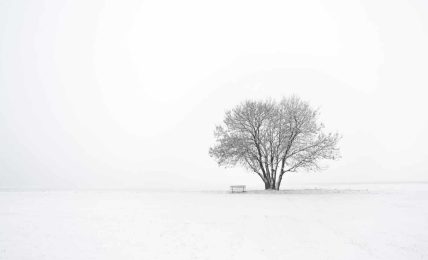VATICAN CITY (RNS) — Some popes go out with a bang. The announcement of Pope John Paul II’s death in 2005 reverberated around the world, and in Rome, locals will tell you that his funeral was the biggest one in memory: Cars were abandoned midtraffic, as mobs rushed toward St. Peter’s Basilica. An estimated 3 million faithful lined up for hours on end to glimpse John Paul’s casket.
By comparison, the news of Benedict XVI’s death, delivered on New Year’s Eve, was met with an an unmistakable air of quiet. While the measure of a pope cannot be determined by his funeral, by the time Benedict was laid to rest on Thursday (Jan. 5), roughly 200,000 people had come to pay their final respects. The few calls for “Santo Subito” — “sainthood now” — from the onlookers at the funeral Mass were muffled by the heavy fog that descended on the square, enveloping the basilica’s dome.
While the unique reality of having two popes, one reigning and one resigned, both living in the Vatican galvanized and frustrated many Catholics, some tourists encountered near St. Peter’s were surprised to hear there was a papal funeral.
“Pope Francis died?” one asked, later expressing confusion at the notion that there had been another pope for almost a decade.
Pope Benedict XVI greets the crowd from the central balcony of St. Peter’s Basilica at the Vatican on April 19, 2005, soon after his election. (AP Photo/Andrew Medichini, File)
Even Roman citizens, their bus redirected to avoid St. Peter’s in the hours before the funeral, demanded to know what event at the Vatican was so important as to interfere with their holiday commutes.
RELATED: Biden visits Vatican embassy to pay respects to Benedict XVI
But if Benedict cannot be credited with helping to take down communism, as John Paul was, or inspiring faith and conversions all over the world, like Francis, this small-framed academic sandwiched between two charismatic pontiffs has arguably left a deeper mark in the history of pontificates.
While Francis is often praised as embodying the ancient idea of pope as pontifex — Latin for “bridge-builder” — for his focus on dialogue and encounter, the title is even more fitting for Benedict.
A young Joseph Ratzinger, as he was born in Bavaria 95 years ago, witnessed firsthand the change inspired by the Second Vatican Council, the historic gathering of bishops in the early 1960s that reformed the way the church engaged with society. He was also there, quietly watching from his post-retirement retreat in the Vatican’s Mater Ecclesiae monastery as Francis launched a new worldwide consultation of Catholic faithful to address the challenges and demands of modernity, the current Synod on Synodality.
With the towers of the cathedral in the background, Cardinal Joseph Ratzinger, later Pope Benedict XVI, bids farewell to the Bavarian believers in downtown Munich, Feb. 28, 1982. (AP Photo/Dieter Endlicher, File)
Benedict personally bridged these two massive reform efforts for a Catholic Church grappling with a new millennium: For years after the Second Vatican Council, he considered himself a progressive before finding himself pulling back, eventually emerging as a conservative icon, and for more than two decades, Ratzinger served as John Paul’s doctrinal watchdog.
In his 10 years in retirement after Francis was elected, his presence in the Vatican was a chain holding together two equally powerful, and powerfully different popes.
In his greatest contribution, in the field of theology, Benedict also acted as a bridge, attempting to reconcile faith and reason — what the world increasingly saw at odds, he saw as intrinsically connected. His work in this field, tying together religion and science, will leave a profound imprint in church thinking.
Some of his bridges from past to future were more trivial — he was the first pope to have a Twitter account (@pontifex, which now tweets for Francis); others constituted important advances, as when he became the first pope to meet with clergy sex abuse survivors.
Pope Benedict XVI attends his weekly general audience in the Paul VI Hall at the Vatican, Aug. 24, 2005. He was the reluctant pope, a shy bookworm who preferred solitary walks in the Alps and Mozart piano concertos to the public glare and majesty of Vatican pageantry. (AP Photo/Domenico Stinellis, File)
And if Benedict’s death was relatively quiet, he had his earthshaking moment when he made his choice to retire, sending shock waves through the church and around the world. While it made history, his resignation also created a new future for his successors, raising the chances exponentially that Francis or any of the popes who follow might take a similar step.
“Benedict’s death felt like a rehearsal,” as one Vatican journalist put it. The 86-year-old Francis has repeatedly declared himself open to the possibility of retiring if his health were to decline. The once rare occasion of a conclave to elect a pope without first burying one could become a trend, eliminating the inconveniences and dangers of drawn-out and aging papacies, as was the case with John Paul.
Benedict XVI asked for a “somber and simple” funeral and got his wish. But the lack of pomp and majesty should not lead anyone to mistake it for insignificance in Benedict’s papacy, which will have a loud echo in the coming years of the church.
This Dec. 8, 2015, file photo shows Pope Emeritus Benedict XVI in St. Peter’s Basilica as he attends the ceremony marking the start of the Holy Year. (AP Photo/Gregorio Borgia)
RELATED: With Benedict’s death, a way opens for more formal rules for retired popes
Share Tweet Share






